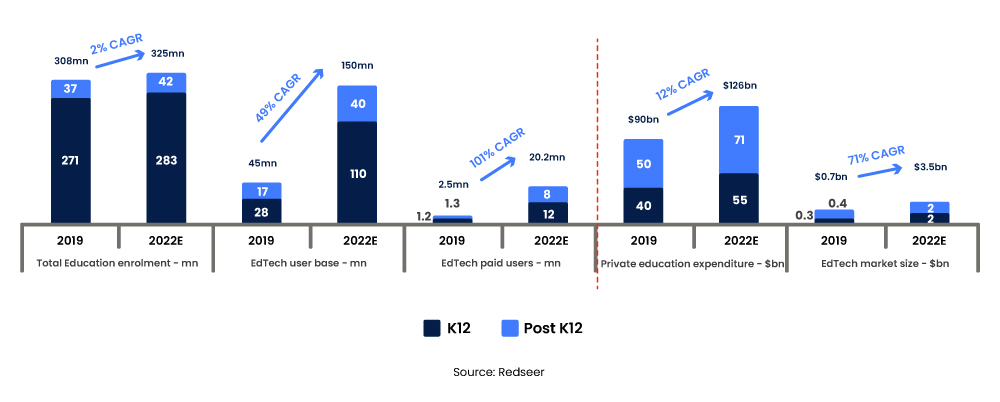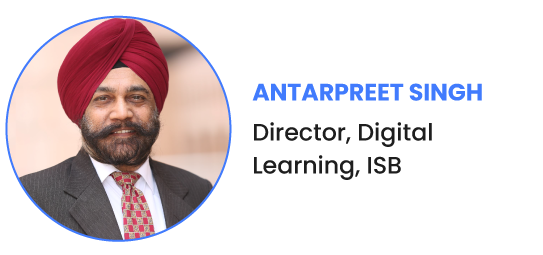
India’s homegrown online education unicorn BYJU’S valued at $12 Billion, has made it to the headlines yet again. After WhiteHat Jr.s’ acquisition for $300 Million, BYJU’S is all set to sign a billion-dollar deal to acquire the test-prep giant Aakash Educational Services, in what would be one of the largest Edtech acquisitions in the world.
Aakash Educational Services is a Blackstone Group-backed brick-and-mortar training giant with over 200 centers and 250,000+ students aspiring to crack and secure seats in the country’s top medical and engineering colleges.
Last year we saw the Edtech industry’s growth accelerate by a measure of several years within a few months, owing to the pandemic. However, as the traditional classrooms gradually reopen, leading Edtechs foresee a deceleration in customer acquisition rates. BYJU’S intent in the acquisition is probably a preemptive action to this opportunity since Aakash famously leads the offline coaching market for test preparation.
There has been much debate about the shape post-Covid learning will take and possible competition between EdTechs and brick-and-mortar training institutes. While online learning startups have seen course subscription rates go through the roof, offline tutoring centers have been severely affected by the pandemic, with schools and tutoring centers closed since March 2020. This uncertainty poses an existential question for the traditional institutes.
Can Offline & Online Education Co-Exist?

The answer is Yes. BYJU’S’ upcoming Aakash acquisition only strengthens the point that even although Covid-19 has left the demand for online lessons soaring, there is a requirement of hybridization in education. With the vaccine coming in, the demand for online learning as the primary mode of education will recede. EdTech companies that foresee this are planning to implement a physical model as well. But then this goes both ways.
In our conversation with Mohammad Zia Siddiqui, C.M.O, Narayana Group, he mentions:
“Training centers have witnessed a 40% reduction in enrollments due to the pandemic, forcing them to slash the fees drastically. While major online educators see this as an opportunity to capture maximum market share, we still cannot say we no longer need brick-and-mortar schools and colleges. There is a need to provide an online experience even for physical institutions right from student onboarding to teaching, in order to thrive.”

Advice for Training Centers:
EdTechs have the advantage of in-house tech-oriented teams, but training centers can also utilize the right set of sales and marketing tools to streamline admissions and provide a seamless student onboarding experience. For student engagement, leveraging free/affordable tools like Zoom, Google Meet, etc. can help the teachers turn into online tutors. Organizations can look at this as a chance to reach a wider audience and not be limited by geography.
Bonus: Check out how Digital Nest increased sales revenue by 10X using Leadsquared
Effects on the K-12 Segment?
With COVID wreaking havoc across the world, the dynamics of learning itself have changed. According to the World Bank report, 190 countries are facing partial or complete school closures affecting the education of over 1.7 billion students. This has impacted the admission rates for various courses and colleges. However, the reformed National Education Policy envisions equitable access to education for everyone thus padding the blows from the strict lockdowns.
There have been multiple changes in the K-12 segment, and institutions are scrambling to embrace technology on all fronts. While teachers and learners are finding it difficult to transition to online modes of learning, admission counsellors for mainstream institutions are struggling with dwindling admission inquiries.
The bigger & more well-known universities & schools are banking on their brand to help them survive the competition from EdTech. But going forward, smaller classical educational institutions must collaborate with EdTechs to sell more courses online.
With multi-national tech companies setting their foot in the education industry, the day might not be far when schools collaborate with organizations such as Amazon Academy to help students prepare for the JEE examination.
According to Dr. Chandrashekhar D.P, CEO, JGI Group,
“Technology, in education, has always existed and has been commonly used in learning and teaching. However, the situation demands us to engage with parents and students with technology. The decision making is happening through technology, which is a gift in disguise to the education sector.”
His Advice for the K-12 Segment:
A 3-step policy in student admission always helps streamline the enrollment to alumni journey for students and parents:
- Awareness – Creating brand awareness through technology. Technology is going to kick-in extensively in the education sector, and we need to train admission agents and educate parents about the offerings virtually.
- Advocacy – We need to create openness and transparency. Engaging students and parents with newsletters, articles, sharing distinguishing features of the institute and course, and offering virtual tours, will make them comfortable enough to trust the brand.
- Action-based promises – With the information asymmetry between the government and institutions, there is confusion among parents as well. Providing information at the right time is going to help build a strong relationship with both parents and students.
Effects on Higher-Education?
India has the world’s largest population of learners and the third-largest higher education sector in the world. About 500 million Indians are in the age bracket of 5-24 years who actively seek education. The education sector in India is estimated at over US$ 91.7 billion – proving a promising future for educational institutions.

The admission process is shifting to digital space, and there is a need to streamline and automate the process for counsellors as well as students. Organizations are adopting an online student onboarding model, which is also helping counsellors close admissions faster. There is a lot of personalization in the sector, and the process in 2021 will be more evolved with an emphasis on one-to-one marketing.
Fact: India is expected to jump to 37 Mn paid Edtech users by 2025 compared to the 10 Mn users in 2020. The test prep segment alone will comprise about 5 Mn users. Moreover, among the four key segments of Edtech – K-12, test prep, online certification, and skill development – the average ticket sizes of test prep and K-12 are expected to see maximum growth. From around $666 spent per user per year, the test prep ticket size is expected to grow 75% to $2,669 by 2025. This would grant BYJU’S a firm footing in one of the most lucrative sectors worldwide.
During our conversation with Antarpreet Singh, Director, Digital Learning, ISB, he stated:
“Edtechs even though an enabler should not be viewed by well-known universities as a threat. At the same time, these institutions & schools have to consider a reality that if they don’t digitally transform, they could perish, as the recent research world over has shown in the context of business organizations as well as educational institutions. Digital Technologies are scale-agnostic – so whether a university/school is big or small – transformation & digital innovation is key to survival and growth.”
His Advice for Higher-Ed Institutions:
Any institution in whatever form it existed before Covid19 will need to embrace a blended or completely online model. While offline teacher-student interactions in a physical classroom/lab environment can continue to exist, they must be replicated for digital classrooms as well.
NEP-2020 offers an opportunity for universities to relook at their portfolios to align them with future skills. They need to broad-base the portfolios, use longer and shorter course formats, and provide flexibilities to the student to exit and reenter the course at multiple points.
Bonus: Download the Admissions Playbook for Higher-Ed institutions

The Correlation Between Digital Transformation and Increased Admission Funnel Size:
The new education policy in India and the change in educational models due to the pandemic have compelled all educational organizations to adopt technology at a much faster pace; the tremendous growth of Edtechs has also accelerated the adoption of tech for offline players.
Universities, Schools, Ed-Techs, and other educational institutions (across cities, towns, and villages) have started to adapt to the online mode of education. The paradigm shift in the Indian education sector from elementary schools to professional education, from tier-3 to tier-1 cities, has proved why it is so critical for offline players to go digital as well. It increases the funnel size for user acquisition drastically. Class sizes are no longer governed by physical limitations and boundaries. Students can learn from anywhere in the world.
Although a hybrid mix of digital and traditional learning has multiple advantages, its success depends on a few key factors:
- Moving from push-sales to pull based sales:
The main issue in the online learning model is that the payer and user are different. i.e. Parents pay, and students use. Often a push-sales model is used rather than focusing on creating an interactive engagement model that incentivizes learning for students on their own. Videos/Gamification/Peer-to-peer learning are a few solutions to tackle this issue.
2. Building a ‘classroom’ like engagement in EdTech:
Traditional learning has the advantage of a classroom experience. Using this in EdTech can help students stay engaged. Leveraging gamification for peer-to-peer learning can maximize engagement and interaction as well as friendly competition.
The Way Moving Forward:
Edtechs have the advantage of reaching a wider audience at an affordable rate but lack a classroom learning experience. Training centers, however, provide a classroom environment but are relatively expensive and cannot cater to different geographies. The pandemic has proven why it is necessary to have a hybrid model in the mix. A collaborative aspect in the learning process provides key benefits such as low cost, convenience, personalization, and connectivity.
Murali Krishna, Director Sales Operations, Education Segment, LeadSquared says
“BYJU’S acquiring Aakash Educational Services has just proved that a hybrid model is the way forward. Brick & mortar institutes will sooner or later have to embrace technology. In the days to come, a prominent market-share will be left with 2-3 major education players. The winner would not take everything, but this would be a game of the fittest. Edtechs will never pose a threat to universities, which will always be a primary source of learning for students. There might be a collaboration where Edtechs will complement the course curriculum with schools, colleges, and skill-based learning schools. With positive signs of the vaccine finally showing, the exponential growth curve for Edtechs will slow down but will continue to grow.”
Bonus: Download the Playbook for Edtech Sales & Marketing












